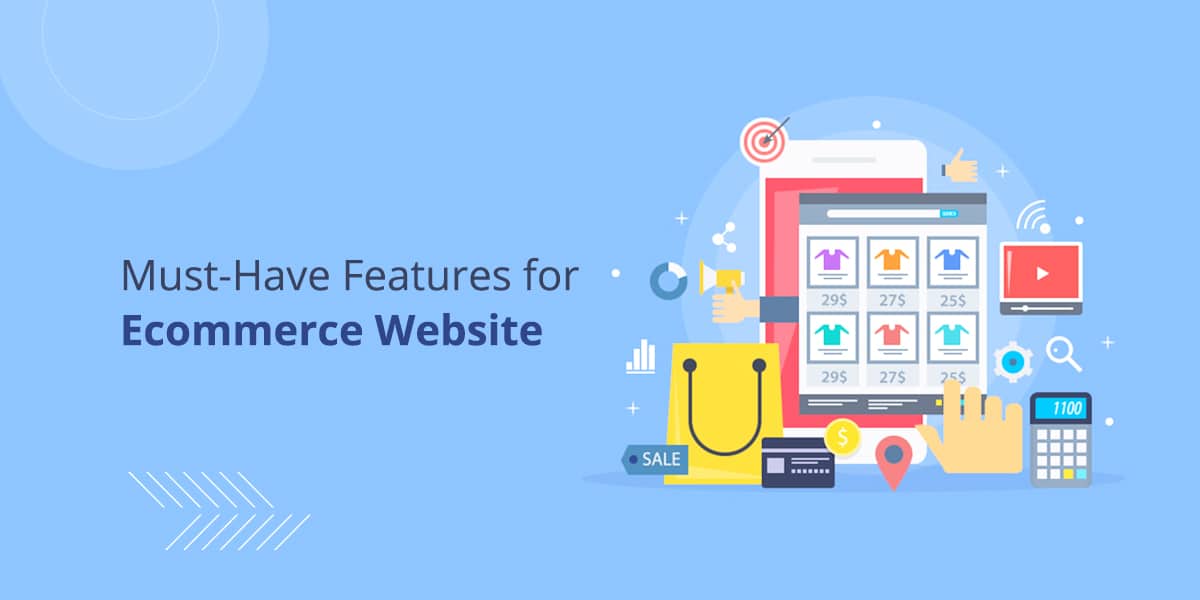Building an eCommerce website is simple, but making it bring the business for you is hard. An eCommerce business can be as small as a one-product store that aims to build authority and follow the path of becoming a one-dish millionaire. Or it can be a multiregional, multilingual, giant marketplace that is running in multiple domains.
A small business can start with a basic eCommerce platform and keep on adding new features as it grows. However, no one can ignore the must-have eCommerce features as these are required for running the online store. It is a virtual world, where buyers are not easily convinced by the offering. You may need to invest in the design to highlight the key selling points most intriguingly.
This post compiles a detailed eCommerce website features list that may help you in recognizing the key aspects you should not miss in setting up and running a webshop.
10 Best Ecommerce Website Features
1. Simple Navigation
User-friendly navigation is among the important features of an eCommerce website. You need to simplify the website navigation so that the end-users can easily find what are looking for. An eCommerce website seems to be complex for a newbie to browse. You may need to classify a huge catalog as marked categories. It must communicate to the users at a glance that the kind of products they need resides in this category.
Similarly, other CMS pages like About Us and Contact Us must also be included in the main menu so that users can easily find and seek help. The main menu, useful links, and buttons must also be made accessible by displaying them in the most prominent positions. It may also take you to customize various buttons with text, style, size, and colors to make them stand out from the design.
2. Mobile-friendliness
Ecommerce websites are using a hybrid kind of digital marketing strategy that primarily includes SEO and Social media. If you are looking for traffic from search engines, mobile friendliness is mandatory as it is considered a major ranking signal. However, to acquire leads from social media, you must also optimize the store with a mobile responsive design. It is no more a trend or best practice only, as it is obligatory now.
3. Provide Multiple Payment Options
Create ease for your potential customers to pay for the shopping the way they want. Not all of them prefer to use credit cards so you must consider other ways of facilitating them. The payment mechanism is among eCommerce website features that should not be missed. Add multiple payment gateways that are popular and easy to use.
For example, people are more comfortable paying with digital wallets like PayPal, Apple Pay, Google Pay, and Ali Pay. You must add payment options that are common among your target users. Displaying icons of the payment options is as important as offering them in your store.
4. Security and Encryption
Online buyers are skeptical about the security of their personal and financial details. They are hesitant to share details with an eCommerce website that is not secured or does not display security labels. Make them trust your website by taking the following security measures.
- Purchase and install SSL (Secure Sockets Layer) certificate
- Integrate credit card verification value (CVV) and Address Verification System (AVS)
- Protect logins with captcha and two-factor authentication
5. Product Gallery
A rich product gallery makes the users stick around the landing page and review further details. You must include high-quality images on the product page. It must cover various aspects of the items like the fabric, make and model, stitch or manufacturing quality, usage, etc. 360-degree photography can be another added attraction to your eCommerce website functionalities. It allows users to have a panoramic view of the product, which is a more captivating and enthralling user experience. Products of technical nature need to display case studies, practical guides, how-to-use, and other instructional manuals on the page.
6. Reviews and Ratings
Collecting and showing customers’ reviews is among the most effective social proof to make the users trust your products or services. Online buyers are now more aware and educated about eCommerce websites so they need to assure the product quality is fine and help other customers too.
The most intriguing part about customer feedback is that such kind of content is produced by the customers themselves, which ensures its authenticity. Try to collect customer opinions and experiences on third-party reviews’ websites and embed them in your eCommerce website to make the most out of them.
7. Show stock availability
Your target users have to go through a complete journey of reaching the cart page. They spend time in web search and product selection before checking out it. You must communicate its availability right on the landing page to prevent disappointment. Sold and available units of products are must-have features for eCommerce website. It saves a lot of their time as they may consider revisiting the website or ask about the restock time. You can improve their experience by setting a restock period for all the products that go out of stock.
8. Highlight Shopping Cart and Checkout Options
Shopping cart and checkout pages are the sales drivers of your store. Let them shine with attractive designs and colors, and display them in prominent positions. Enhance the shopping cart and make it more informative with details like product name, quantity, price, and other important SKUs. Allowing users to modify their selection on the cart page is also significant.
Evaluate the design of the checkout page. If it includes unnecessary options and fields, try to remove them or replace them with relevant fields. You can consider summarizing the multistep checkout page into one page for a smooth shopping experience.
9. FAQs page
Frequently Asked Questions (FAQs) is a list of commonly asked questions or the possible queries the users may ask. You can compile the list and answer them with detailed and satisfactory replies, and display them on a dedicated page. If you are doing it for the first time, you need to brainstorm all the questions that may arise in the mind of your potential customers. Writing FAQs, dedicating a page, and projecting them on other pages are the key features of an eCommerce website. It improves user engagement, trust, and credibility.
10. Multiple options to contact
A usual Contact Us page includes a simple form that requires users to share email and write what they need to know. It is a time-consuming medium of communication and most users are reluctant to share their email addresses. You can share your phone number to make a call.
Add a chatbot that has pre-configured questions and answers. The users click a question and get an instant reply. A further enhancement in customer support is configuring an artificial intelligence-based chatbot that asks users to ask anything and then projects the most relevant answer from the database.










